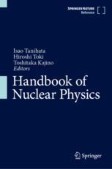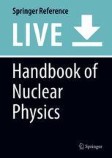Search
Search Results
-
Kilonovae
The coalescence of double neutron star (NS–NS) and black hole (BH)–NS binaries are prime sources of gravitational waves (GW) for Advanced LIGO/Virgo...

-
Science with a Small Two-Band UV-Photometry Mission I: Mission Description and Follow-up Observations of Stellar Transients
This is the first in a collection of three papers introducing the science with an ultra-violet (UV) space telescope on an approximately 130 kg small...

-
Dynamics and Equation of State Dependencies of Relevance for Nucleosynthesis in Supernovae and Neutron Star Mergers
Neutron stars (NSs) and black holes (BHs) are born when the final collapse of the stellar core terminates the lives of stars more massive than about...
-
Dynamics and Equation of State Dependencies of Relevance for Nucleosynthesis in Supernovae and Neutron Star Mergers
Neutron stars (NSs) and black holes (BHs) are born when the final collapse of the stellar core terminates the lives of stars more massive than about...
-
A large-scale magnetic field produced by a solar-like dynamo in binary neutron star mergers
The merger of two neutron stars launches a relativistic jet, which must be driven by a strong large-scale magnetic field. However, the...

-
Electromagnetic Counterparts of Gravitational Waves in the Hz-kHz Range
On the 17th of August 2017, the first detection of gravitational waves from the coalescence of a neutron star binary and the observation of its...
-
The evolution of binary neutron star post-merger remnants: a review
Two neutron stars merge somewhere in the Universe approximately every 10 to 100 s, creating violent explosions potentially observable in...

-
Multi-messenger Astronomy
On 2015 September 14, the first observation of gravitational-waves by the Advanced Laser Interferometer Gravitational-wave Observatory detectors...
-
Black Hole-Neutron Star Mergers
Pushed by the rapid rise of gravitational wave astronomy, the study of compact binary mergers has made significant progress over the last 5 years....
-
The production of actinides in neutron star mergers
Although the multimessenger detection of the neutron star merger event GW170817 confirmed that mergers are promising sites producing the majority of...

-
The origin of polarization in kilonovae and the case of the gravitational-wave counterpart AT 2017gfo
The gravitational-wave event GW 170817 was generated by the coalescence of two neutron stars and produced an electromagnetic transient, labelled AT...

-
r-Process Nucleosynthesis from Compact Binary Mergers
The merger of two neutron stars or of a neutron star and a black hole often results in the ejection of a few percents of a solar mass of matter...
-
Electromagnetic Counterparts of Gravitational Waves in the Hz-kHz Range
On the 17th of August 2017, the first detection of gravitational waves from the coalescence of a neutron star binary and the observation of its...
-
A long-duration gamma-ray burst of dynamical origin from the nucleus of an ancient galaxy
The majority of long-duration (>2 s) gamma-ray bursts (GRBs) arise from the collapse of massive stars, with a small proportion created from the...

-
Science with the 2.5-meter Wide Field Survey Telescope (WFST)
The Wide Field Survey Telescope (WFST) is a dedicated photometric surveying facility being built jointly by University of Science and Technology of...
-
Atomic and molecular data and their applications: ICAMDATA 2022
This Editorial provides the general introduction to the collection of papers originated by the 12th ICAMDATA, recalling the inspiring principles of...
-
r-Process nucleosynthesis in gravitational-wave and other explosive astrophysical events
Gravitational-wave detectors have transformed the way we observe the Universe. Together with ground and space electromagnetic observatories, they...

-
MeV astrophysical spectroscopic surveyor (MASS): a compton telescope mission concept
We propose a future mission concept, the MeV Astrophysical Spectroscopic Surveyor (MASS), which is a large area Compton telescope using 3D position...

-
Rates of compact object coalescences
Gravitational-wave detections are enabling measurements of the rate of coalescences of binaries composed of two compact objects—neutron stars and/or...

